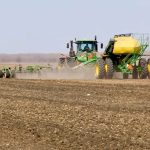
Forages

Benefits to farmers of testing forage seed
The benefits of testing forage seed can be long-lasting
When establishing a new forage stand that will ideally be productive for five or 10 years, producers want to set themselves up for a good outcome. Using high-quality perennial or annual forage seed that is certified — or tested for purity, germination and viability — is a good place to start. “There is a certain […] Read more

Canola, Cereals, Corn, Crops, Forages, Hay, Pasture, Peas, Pulses, Soybeans, Spring Wheat, Winter Wheat
Manitoba crops in good shape: Report
Rainfall amounts vary widely
Crops in Manitoba continued to come along nicely, the provincial agriculture department reported for the week ended June 24.

Drought preparation is better than reaction
News Roundup from the June 2025 issue of Canadian Cattlemen
Glacier FarmMedia – When it comes to drought, imagining the worst may be the best way to start planning for it. Wayne Knight, executive director for Holistic Management International, is originally from South Africa, a country known for drought and dry conditions. Because of his background, he’s learned to always be prepared for drought. “I […] Read more

Evaluating forage performance in different environments
Research on the Record with Reynold Bergen
About 20 years ago, Doug Wray drove in from Irricana, Alta., for an informal meeting at the Alberta Beef Producers’ office, where I worked at the time. He asked why the beef industry didn’t fund more forage breeding. Back then, the usual beef industry response to forage breeding proposals was “Let the government and forage […] Read more

Manitoba crops 99 per cent planted
Five points ahead of average
Seeding operations across Manitoba largely wrapped up during the week ended June 10, with 99 per cent of intended acres in the ground, according to the latest provincial crop report. That was up four points from the previous week and compares with the five-year average of 94 per cent done.

Reintroducing fire to Saskatchewan pastures
Prescribed burns can be effective at revitalizing native grasslands when done right
Pastures evolve over time. Woody plants and shrubs, which cattle can’t eat, may encroach on natural grasses. Invasive species, such as Kentucky bluegrass, may also move in, cutting into native grass productivity. One way of managing this is through fire. At the Saskatchewan Beef Industry Conference, Eric Lamb and Renny Grilz presented recent research regarding […] Read more

VIDEO: Doing the math on cattle grazing
Depth of Field with Kelly Sidoryk
An integral component of good grazing management is tracking yield or production. It is how we project carrying capacity and adjust for drier or wetter conditions. It’s also an important part of the planning process. When we switch to a more intensive grazing approach, with multiple paddocks and grazing periods based on plant recovery, tracking […] Read more

Spring planting in Manitoba close to finished
Province gets very little rain over the week
Dry conditions continued to spur quick seeding progress in Manitoba, as the provincial agriculture department reported spring planting reached 95 per cent complete as of June 3.

Manitoba seeding 12 points ahead of pace
Most spring wheat in the ground
Manitoba farmers pushed their spring planting to 57 per cent complete as of May 21, up 24 points from a week ago, the province's agriculture department reported.

New Canadian Cattle Association president focused on trade risk
Tyler Fulton is no stranger to hard work — a trait he now brings to his role at the Canadian Cattle Association
Tyler Fulton is no stranger to hard work — a trait he now brings to his role at the Canadian Cattle Association
As a cattle rancher himself, Tyler Fulton is passionate about serving his fellow farmers and ranchers. In March of 2025, he was named the new president of the Canadian Cattle Association at the annual general meeting in Ottawa, Ont., allowing him to do so even more. “I really feel fortunate to be in this role, […] Read more


